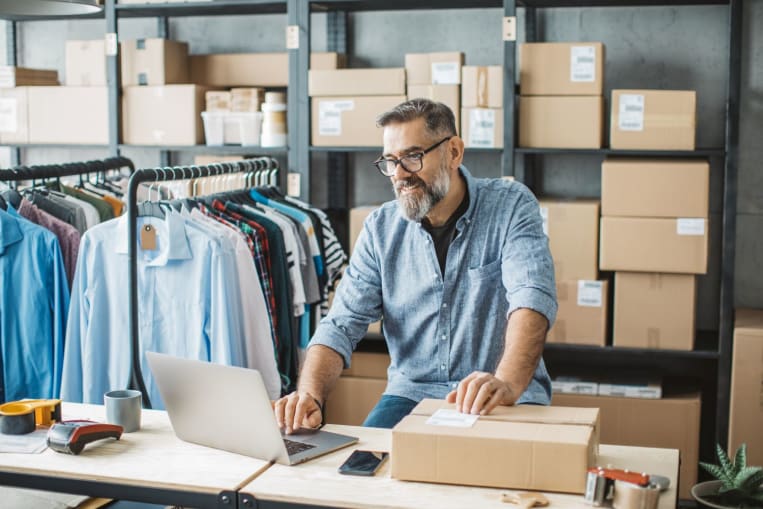
BBB Business Tip: 3 ways to drive sales using local online marketplaces

Business owner working on computer (Getty Images)
In the last few years, a huge shift in consumer behavior has occurred, with more and more people purchasing items online. It's estimated that by 2040, e-commerce will facilitate over 95% of all mobile purchases. Virtual storefronts sell a wide range of products and services, providing consumers with a seamless and convenient shopping experience. These online marketplaces sold more than $3.23 trillion of goods and services in 2021.
Online marketplaces are so lucrative because people using these platforms are often ready to make a purchase. And there is a huge opportunity for your business if you can show consumers that your product or service is a solution to their needs.
Getting your product or service to stand out on some of the top online marketplaces can be a daunting task. Though they give businesses a way to reach a large customer base, there is so much competition that it's hard to rank high enough in search results for potential customers to find you.
But shifting your focus to activating local online marketplaces can be a great opportunity to drive sales. These storefronts focus on local communities, and here you can create a more direct relationship with customers at a lower cost. Think of it as reverse geo-targeting. Instead of spending money on social campaigns trying to reach local customers, you're finding where they are purchasing online and going directly to them.
ROI is one of the main concerns for businesses both large and small. Finding consistent ways to drive sales in a crowded online space takes a mixture of creativity and concentrated marketing efforts. Here are three ways that you can reach new consumers through local online marketplaces.
1. Use emotional images.
Humans are inherently visual. The care you place in selecting compelling images to showcase your product or service has a huge impact on consumers and their decision to buy. Local marketplaces are usually filled with individuals trying to sell items they don't want. As a result, the photos and layout used to showcase the product often look unprofessional. Using high-quality images that trigger an emotional response gives consumers additional trust in the seller, making them more likely to buy.
But be sure your image doesn't look too polished so people don't perceive it as advertising. If you sell products, consider shooting the image similar to how would display it on social media. Use techniques such as flat lay photography. If you sell a service, try to create an action or lifestyle shot so customers can imagine how your service would fit into their everyday life.
2. Improve your SEO and keywords.
Effectively using SEO and high-value keywords on your website can also help to drive sales on local online marketplaces. Some of the bigger marketplaces even have their own keywords that factor into how products rank in search. Choose relevant keywords that fit both your location and your product. This will help you to be seen when consumers are actively looking for the types of items you sell. You can improve your overall reach without spending more money on marketing and advertising. If you need help finding the right keywords or tips on other things you can do to help SEO, sites like SEMrush and Moz can be helpful, and Google provides SEO guidelines as well.
You should also make sure your product or service is listed on Google Shopping. Google has 93% of the global search engine marketing share. So though improving your overall SEO is important, making sure your product is listed in Google Shopping can improve your search engine ranking, leading to more discovery and consequently more sales.
3. Make an online connection that becomes an offline relationship.
If a customer finds you via a local marketplace, it's important to let them know that your business also has a brick-and-mortar space in their area. This can be done via the product description or through direct messages. Even though online shopping is growing, many consumers still prefer traditional retail and real-life shopping experiences. And 71% of consumers spend more money in-store than they do online. Find customers online and invite them to come to visit you in person.
Try to pair the look and feel of your online marketplace with that of your physical retail space. By doing this, you will create a sense of brand trust, which is key for repeat customers. Once they're in-store, you've also opened up the potential that they will share your business on their own social network accounts. This action can provide additional social proof and open your business to an additional group of new customers.
Think local when it comes to online marketplaces to help drive growth while also providing a curated experience for your customers.
For more great tips and tricks on improving your copywriting skills, check out the BBB business news feed and the BizHQ.
BBB Great West + Pacific contributed this article.
Still Need Assistance?
Contact Your Local BBB
Your local Better Business Bureau can assist you with finding businesses you can trust. Start With Trust®.
Additional Resources
Let BBB help you resolve problems with a business
Research and report on scams and fraud using BBB Scam Tracker
Learn more about the value of BBB Accreditation